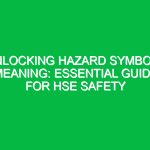Introduction
In the realm of health, safety, and environment (HSE), hazard signs and symbols are crucial elements designed to communicate risks and promote safety awareness. These visual cues serve as immediate indicators of potential dangers, facilitating swift responses from individuals in various environments, be it industrial, commercial, or public spaces. Understanding hazard signs and symbols is not merely an academic exercise; it is an essential practice that can save lives and prevent injuries.
The significance of hazard signs and symbols cannot be overstated. They are a universal language that transcends linguistic barriers, ensuring that everyone—from workers in a factory to visitors in a public park—can recognize and respond to hazards effectively. This article delves into the various types of hazard signs and symbols, their meanings, and their importance in fostering a culture of safety.
Understanding Hazard Signs and Symbols
Hazard signs and symbols come in various shapes, colors, and designs, each conveying specific information. They are categorized into several types, including warning signs, prohibitory signs, mandatory signs, and emergency information signs. Each category serves a distinct purpose and is governed by specific regulations to ensure consistency and clarity.
Types of Hazard Signs and Symbols
Warning Signs
Warning signs are typically yellow or orange and indicate a potential hazard that may cause injury or damage. Common examples include:
- Slippery Surface: Often marked with a symbol of a person slipping, this sign warns of wet or icy surfaces.
- High Voltage: A lightning bolt icon warns individuals of the presence of high voltage electricity.
These signs are crucial in environments where hazards are not immediately visible, allowing for proactive measures to be taken.
Prohibitory Signs
Prohibitory signs are usually red and indicate actions that are not allowed. Examples include:
- No Smoking: A cigarette crossed out signifies that smoking is prohibited in that area.
- No Entry: A red circle with a line through it indicates that entry is not permitted.
These signs help manage behaviors that could lead to accidents or hazardous situations.
Mandatory Signs
Mandatory signs are blue and indicate actions that must be taken. For instance:
- Wear Safety Goggles: A symbol of goggles indicates that eye protection is required in specific areas.
- Safety Helmet Required: A hard hat icon signifies that head protection must be worn in the vicinity.
These signs compel individuals to follow safety protocols that protect them from workplace hazards.
Emergency Information Signs
Emergency information signs provide crucial details about emergency procedures or exits. Examples include:
- Emergency Exit: A green running man icon indicates the direction of the nearest emergency exit.
- Fire Extinguisher: Signs indicating the location of fire extinguishers are essential for quick access during emergencies.
These signs play a vital role in ensuring that individuals can react quickly and effectively in emergencies.
Benefits of Hazard Signs and Symbols
The implementation of hazard signs and symbols brings numerous benefits, enhancing workplace safety and promoting a culture of awareness. Here are some of the key advantages:
Enhanced Safety Awareness
Hazard signs and symbols serve as constant reminders of potential dangers. Their presence encourages individuals to remain vigilant and adhere to safety protocols. For instance, in a manufacturing plant, the consistent display of warning signs can significantly reduce the likelihood of accidents.
Reduction of Accidents and Injuries
Properly placed and understood hazard signs can lead to a measurable decrease in workplace accidents. A study conducted in a chemical manufacturing facility revealed that the introduction of clear hazard signs led to a 30% reduction in incidents over six months. This illustrates the direct correlation between effective signage and safety outcomes.
Legal Compliance
Organizations must comply with various regulations concerning hazard signs and symbols. Adhering to these regulations not only avoids legal repercussions but also demonstrates a commitment to employee safety. For example, the Occupational Safety and Health Administration (OSHA) in the United States has specific requirements for hazard communication that organizations must follow.
Best Practices for Using Hazard Signs and Symbols
While hazard signs and symbols are vital for safety, their effectiveness depends on proper implementation and maintenance. Here are some best practices to ensure optimal safety outcomes:
Clear Visibility and Placement
Hazard signs should be placed in locations where they are easily visible and unlikely to be obstructed. For instance, a warning sign about a slippery floor should be positioned at the entrance to the area, ensuring that individuals see the warning before entering.
Regular Audits and Maintenance
Conducting regular audits of hazard signs and symbols is essential. Signs that are faded, damaged, or obscured by other objects should be replaced or repositioned immediately. This proactive approach ensures that safety information is always clear and accessible.
Employee Training
Training employees to recognize and respond to hazard signs is crucial. Regular safety meetings can reinforce the meanings of different signs and symbols, ensuring that all individuals understand the risks and the necessary precautions.
Use of Technology
Incorporating technology into safety protocols can enhance the effectiveness of hazard signs. For example, digital signage can be updated in real time to reflect changing conditions, such as temporary hazards in a construction site.
Regulations and Standards Governing Hazard Signs and Symbols
Various regulations govern the use of hazard signs and symbols, ensuring consistency and effectiveness across different sectors. Understanding these regulations is essential for organizations aiming to maintain compliance and promote safety.
OSHA Regulations
In the United States, OSHA has established guidelines for hazard communication, including the proper use of signs and symbols. OSHA‘s standards require that employers communicate the hazards associated with chemicals and other materials, ensuring that employees are informed and prepared.
International Standards
Globally, organizations such as the International Organization for Standardization (ISO) have developed standards for hazard communication. ISO 7010, for example, establishes graphical symbols for use on safety signs, promoting a standardized approach to hazard communication worldwide.
Industry-Specific Regulations
Certain industries have specific regulations regarding hazard signs and symbols. For instance, the construction industry is governed by regulations that require clear signage to indicate potential hazards such as falling objects or electrical dangers.
Conclusion
In conclusion, hazard signs and symbols are indispensable tools in the HSE domain, serving as vital communication mechanisms that promote safety awareness and prevent accidents. Their diverse forms—warning, prohibitory, mandatory, and emergency information signs—provide essential information that can significantly impact workplace safety.
The importance of understanding and properly implementing hazard signs cannot be overstated. They not only enhance safety awareness but also contribute to compliance with legal standards and the reduction of workplace injuries. By following best practices, organizations can ensure that hazard signs remain effective and serve their intended purpose.
As we move forward, it is essential for all individuals—employers, employees, and visitors—to recognize the significance of these signs and symbols in fostering a culture of safety. By committing to safety and actively engaging with hazard signs, we can create safer environments for everyone.


